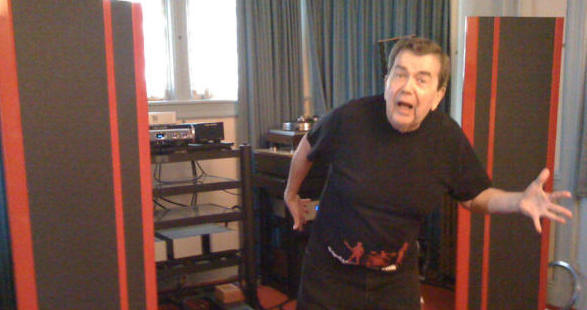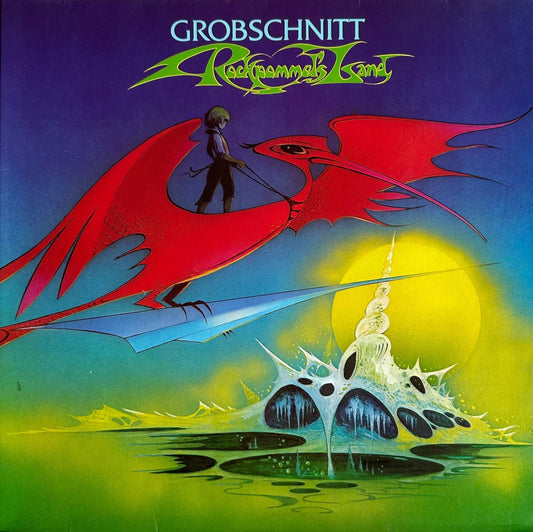I discovered high-end audio in 1978. But I always seemed to have a natural inclination towards high quality experience. My father was a largely self-trained EE, who was hired at RCA Camden for his first job in the US in 1951. He built our hi-fi systems at home including what I recall as the first stereo system in the neighborhood. He had a shop in our basement where he built analog computers in the 1960s for his employer in Philadelphia. Everyone in our family except me was an expert at soldering—I only knew how to draw and paint, and by the beginning of the 1970s, that had evolved (or, if you were as disappointed as some of my family members were, devolved) into me being a musician.
Next to my dad’s tool benches, the basement was filled with walls of amps and drums – our house was the hang for incipient rockers.
My first real encounter with the possible came at age 16 when I wandered into Alembic, then a small custom instrument and sound-system shop in San Francisco, in 1973. Alembic was an outgrowth of the search for [sonic] purity and control on the part of Owsley Stanley and the Grateful Dead. I spent a day with company head Rick Turner, who helped me discover what was possible with bass sound and who showed me what he had been doing for my heroes Jack Casady and Phil Lesh. I had gone in seeking knowledge and was amazed at how much there was to find.
Rick would be guru number one.
Three years later I began my recording career at a small studio in San Diego. My first experience of hearing the playback after our initial take was jarring—where was the magic? We sounded like…ourselves. So disappointing. I expected tape to perform miracles and make us sound like a record, not like a direct feed off the mics.
The engineer who brought us into this studio was Doug Sclar, and the 24-track tape recorder [at the studio] was a Stephens. Doug would be guru number two. He was,
at the time, helping build Seals and Crofts’ Dawnbreaker Studios in LA (which used a Helios console). It never occurred to me to say what I was thinking about the fidelity of the sound at the time—it was simply something I noted—that tape is basically inaudible. In following years I’d find that was anything but true; and that the exception was the Stephens machine.
But this was my first blush [with the recording studio] and I found it really disorienting. A couple years later I lived briefly at Doug’s house in Orange County, transiting from San Diego to LA. Doug knew his stuff: he had a Technics SP-10, an Infinity Black Widow arm and Micro-Acoustics cartridge, Levinson ML2 amplifiers, Threshold (heavily, personally modified) and Quatre Gain-cell amps driving Dahlquist DQ-10loudspeakers which he had [made into] mirror–imaged [pairs] and changed the caps on. This was news – that records could sound like this; that in fact records did sound like this. Doug called it depth—I didn’t know what to call it.
Up to this point I had noticed two things. My first [stereo] system had a Garrard changer built into the top of a Realistic receiver and Sony tape recorder speakers. I noticed that if the speakers were set right, that Jorma Kaukonen’s acoustic guitar on the first Hot Tuna album sounded surprisingly real, but only in one of the rooms of our house, and no other instrument did. And when I went to buy my first pair of real speakers, I ended up with AR-16s because the percussion on Weather Report’s “Birdland” leapt out of the mass of speakers on the wall and hovered in the air.
But Doug’s system was something else—like looking deep into space. I asked Doug how I could learn more, and he handed me a pile of magazines including The Audio Critic. I started reading them, was appalled by the snobbery of the content, and lost interest in the topic.
In 1981 I was working for a sound-effects guy, doing his books, some engineering and ghostwriting technical articles. He had some thoughts for modernizing the sound-effects craft (which had been defined five decades earlier) and I spent some time interviewing a number of people around Hollywood, figuring out how the concept would work, and a few audio-engineering magazines published these pieces. Shortly after, he was hired [to work on the movie] Tron—this is when I met Michael Fremer. [Fremer is the editor of Analog Planet and a reviewer for Stereophile – Ed.]
I worked for a while directly with Michael, who was in charge of the postproduction sound on the film, music and sound effects. Disney sent over a 2-inch multi-track tape,
which is what the initial layer of effects were laid onto (like the “harmonized” motorcycle engine revs for the light-cycle sequence). I had to wire up the tape machine to interface with the studio’s less-than-pro recording console. [During the time] the work accelerated, I left the company.
The following spring I was playing my first show as the bassist in Terry Reid’s band and heard someone down in front shouting my name. The next day my phone rang—it was Fremer. We hung out, I listened to his system, asked the same questions of him I’d asked of Doug, and he sent me home with a few issues of The Absolute Sound. Now I was interested. These people made sense to me—yeah, some snotty tone here and there, but mostly a group of curious and serious enthusiasts, trying to figure out what was going on and how to get closer to the source [of the music]. Even without knowing them or anything about them, it felt collegial, not preachy.
A couple of months after this, I was hired to score a film: I put together a studio in the director’s house (formerly director Preston Sturges’ house), around yet again a Stephens tape deck. Suddenly, I found myself with more money in the bank than a guy living an early-80s avant-gardist punk-rocker life could use in a year. So…of course—spend it! Michael and I went out and found me the beginnings of a good system, and off I went, ensnared in the search. But, not alone. I had the whole [printed] world of The Absolute Sound with me.
Not long after Michael went east to become pop music editor at TAS, I called him up to berate him for what I felt was a very poorly written survey on the records of someone I cared about (not written by him personally, but he was editor). His riposte was to taunt me into doing better, and so I was handed my first assignment, which led to [then managing editor] Sallie Reynolds inviting me to participate more regularly. Later that year I was visiting back east and spent a day in Sea Cliff with Sallie at the office and Harry Pearson in Music Room 3, [the main listening room].
Anyone who has been there never forgets their first time. HP is good at the socks-blown-off thing.
Writing for TAS was, for me, writing to Sallie and HP. It was easy to “speak” to them, to conduct my side of an imaginary dialogue with two people I came to like very much and with whom I had plenty to really talk about on many topics—on every topic. We struggled a while, with me pushing to be allowed to find and then write as I thought rather than in the style of the magazine, but we got there and the more we got there the less I disliked reading my own writing; the more truthful it felt. I can’t give higher praise than to say they went along with this. There wasn’t a set message being pushed, there was more a sense of, “We’re all moving to a wide-open place together.” In my opinion, that brought some journalistic responsibility along with it. We owed it to ourselves and to each other to remember that we were doing something for a community, not for our own self-gratification.
A lot has changed since those days—in the high end, in the magazines, and obviously, in the world. At this point, it’s hard to even know if a journal that was so blatantly amateur has any place. When I say amateur, I mean it in the best sense—from the heart. [Back then,] TAS was published erratically, writers were never sure when a check would come or for how much it would be, and there were lots of complaints about that. I don’t care to dispute the complaints.
Certainly in the years after the re-organization, the trains ran on time. You could count on a check, you’d know how much it would be for, and readers could rely on a professional delivery schedule. None of this, ultimately, triggered my departure, but it went a long way towards creating a sense—and I acknowledge that I wouldn’t expect anyone else to share this sentiment with me—that the “mom and pop” (i.e., HP and SR) quality of the journal that I so loved had given way to agendas that, while not necessarily bad in any way, were simply something I had no interest in. The world had really changed. The world has really changed.
Courtesy of Positive Feedback (www.positivefeedback.com), where it originally ran in 2014. Reprinted in edited form here with permission. Header photo courtesy of Positive Feedback.



